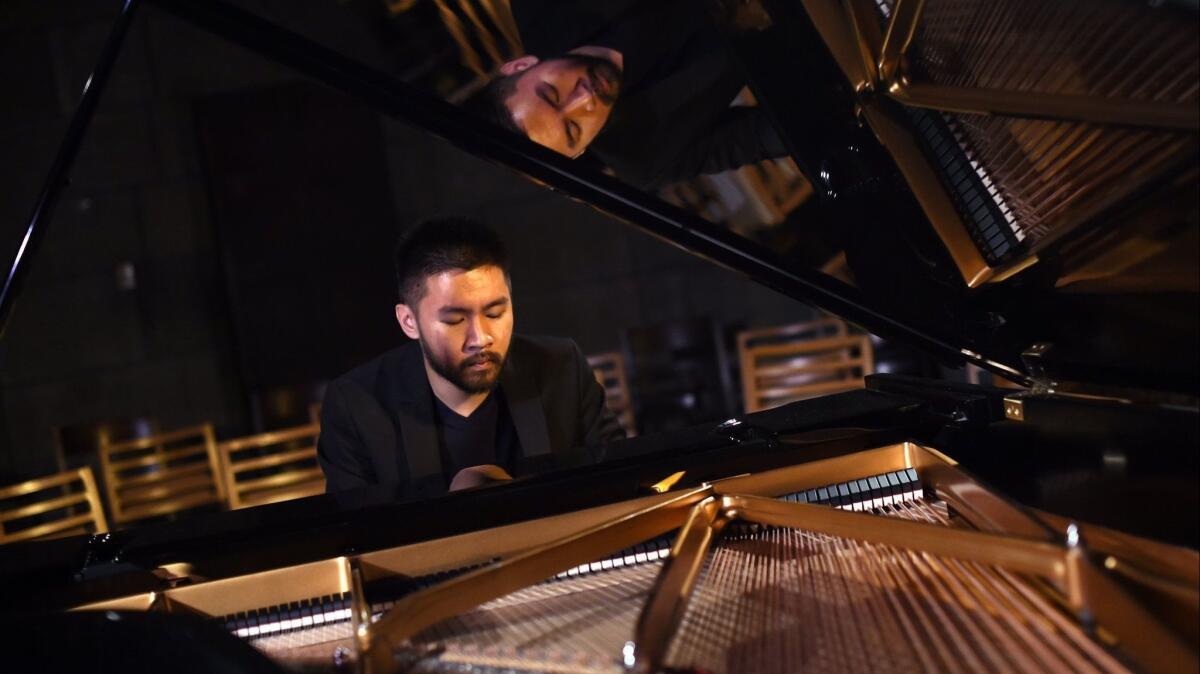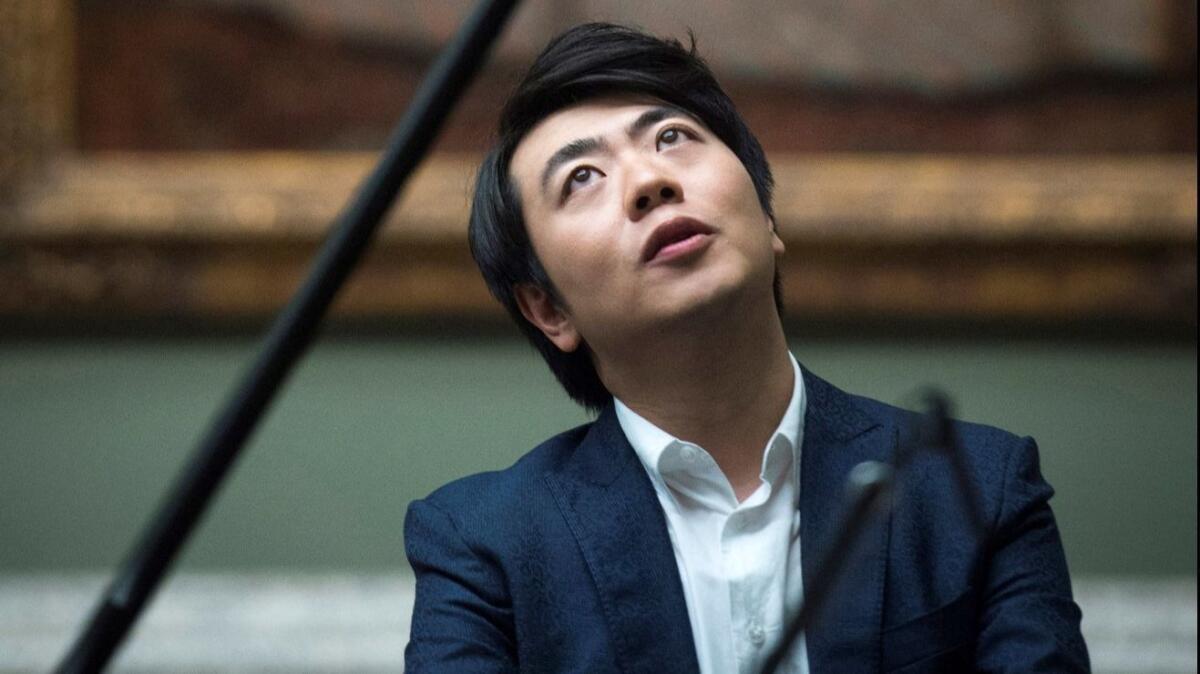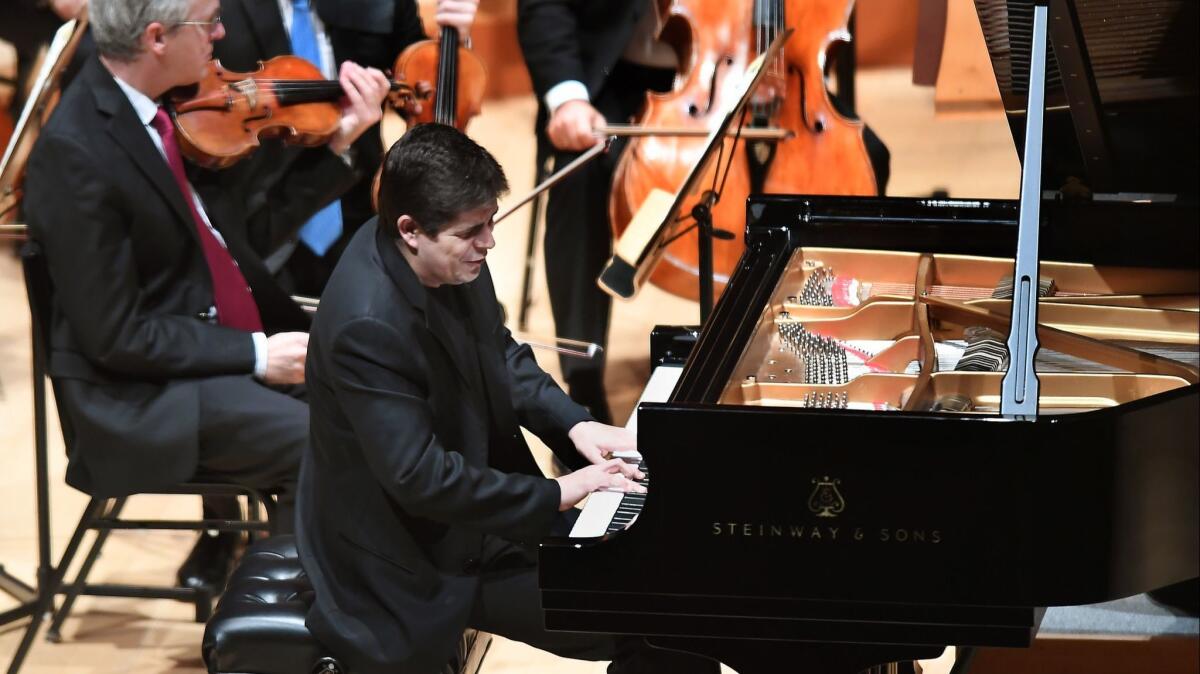How the L.A. Phil turned Beethoven’s piano concerto marathon into a relay
- Share via
Stormy, emotionally charged harmonic shifts. Flowing classical lyricism interrupted by lightning bolt chords. Propulsive rhythmic themes swept along by avalanches of rapid scales and arpeggios. Beethoven’s piano concertos, composed between 1793 and 1809, stand tall at the center of music history like a mountain range with five daunting peaks.
Star Chinese pianist Lang Lang was set to traverse all five of those peaks with Gustavo Dudamel and the Los Angeles Philharmonic this month. But in December, the orchestra announced that Lang Lang would play just one concerto, allowing him recovery time from an injury that recently limited his performing schedule.
Four pianists are pinch-hitting: Conrad Tao, Beatrice Rana, Yulianna Avdeeva and Javier Perianes.
With this marathon effectively converted to a relay, audiences have been taking in Beethoven’s piano concertos from the perspective of five diverse soloists.
The Times spoke with most of them by phone recently while they were dispersed around the world –– playing Chopin in Australia, accepting an award in Switzerland, rehearsing in New York or Rome. (Lang Lang answered questions via email.)
Each pianist spoke passionately about the humanity and emotion embedded in Beethoven’s harmonic impulses. Each mentioned the remarkable stylistic transformation from Classicism to Romanticism represented across these works. And all of them pointed specifically toward the middle, typically more lyric second movements as intimate moments they relish performing, like taking a deep breath next to a shimmering mountaintop lake after a long hike.
Here are excerpts from those conversations, edited for length and clarity.
Conrad Tao
Age: 24
Born: Illinois
Performed: Beethoven’s Piano Concerto No. 1 in C Major, Op. 15, on Saturday
On this concerto: It’s hefty and rich. In the development section of the first movement, he forces you to feel the harmonic tension and movement.
I love performing the duet in the second movement with the clarinet. It’s just really beautiful, and it arrives at a perfect center point for the whole concerto.
One great thing about being both a performer and composer is that my relationship to notation is multifaceted. I’ve been playing this concerto regularly for six or seven years, and this time around, I’ve been spending time with the holograph manuscript, which is freely available in PDF form online. Immediately, you can see different permutations of what the piece could have been. He scratches out so much, and he’s revising endlessly. On one level, it reminds you that there’s a person on the other side of that seemingly immortal gap between you and the composer. If you can connect with that human, it’ll be something new, because it’s yours.
On past performances of the entire Beethoven cycle: I just remember it being ridiculously fun.

Lang Lang
Age: 36
Born: China
Performed: Beethoven’s Piano Concerto No. 2 in B-flat Major, Op. 19, on Friday and Sunday
On this concerto: I chose to play this concerto because it has always been one of my favorites. You can feel and hear the transition from the classical tradition to the more dramatic Beethoven. Unlike other early works by Beethoven, which are often lighter, this concerto is already quite dramatic, but at the same time very elegant.
I especially love the slightly complex cadenza, which Beethoven wrote himself at a later stage. And I love the second movement, with its beautiful poetic images and the way it contrasts with the third, which is full of humor and rhythmic verve.
On his recovery from injury: Everything is great. My left hand is completely recovered.

Beatrice Rana
Age: 26
Born: Italy
Performed: Beethoven’s Piano Concerto No. 3 in C Minor, Op. 37, on Saturday
On this concerto: When I was young, this concerto was my favorite of the five. Now, I think that my favorite is the fourth. But still I love the third very much, especially the beginning. It’s actually the only Beethoven concerto in a minor key, and that’s why the beginning is very dramatic. It’s a powerful piece, and in a way, it’s a turning point in his writing, because the first two are youthful pieces of music, and this one begins a new chapter, so it’s a moment of a lot of changes.
This concerto begins with an orchestral introduction that is very mysterious at first, and then by the time the piano enters, it is furious. I like very much that big duality, on one side drama and power, and on the other side such cantabile and a poetic approach to life.
I think there are two striking moments in the concerto. One is the second movement, which is a gem. It’s really the heart of this concerto. And the other comes in the cadenza in the first movement. The piano just seems to explode.
The interesting thing about this Beethoven concerto cycle is that there is one orchestra and one conductor providing a link of interpretive integrity across all five concertos. But I think that pianists can bring a very personal point of view to their performances, because each concerto shows a different side of Beethoven.
On performing music written more than 200 years ago: Even if the time has changed a lot, the human feelings are always the same.

Yulianna Avdeeva
Age: 33
Born: Russia
Performing: Beethoven’s Piano Concerto No. 4 in G Major, Op. 58, at 8 p.m. Thursday and Friday
On this concerto: This is actually the last of the five that I learned, and I’m very happy that was the case, because it is a very special piece. Even among Beethoven’s other works, it stands absolutely apart as one of the deepest pieces I know. Of course, the structure is very unusual and was absolutely unique for its time. At the very beginning, it’s just the piano without an introduction from the orchestra. The sounds of those piano chords seem to just come out of nowhere. Every note in this concerto somehow is like from another dimension. Every note has a certain meaning, in my opinion.
The spirit of this concerto is very different from No. 3 and No. 5, which are dramatic, grand, majestic. No. 4 is much more intimate and personal. It’s Beethoven really sharing some private feelings and thoughts which are very unique and deep.
On being an audience member at a classical concert: It is a place and time when you are really on your own with your own soul and your own thoughts. It’s not easy to fine equivalent moments in our lives now.
Javier Perianes
Age: 40
Born: Spain
Performing: Beethoven’s Piano Concerto No. 5 (“Emperor Concerto”) in E-flat Major, Op. 73, at 8 p.m. Thursday and Friday
On this concerto: This concerto contrasts greatly with No. 4, which we are going to listen to in the same night. No. 4 is about improvisation, intimacy and poetry. No. 5 is about heroic things.
This is the last one he composed, and it’s the only one he didn’t premiere himself (his pupil, Czerny, played it for the first time). We can start to feel every single characteristic of the Romantic era in this concerto. It’s virtuosic, it’s heroic, but at the same time we can find moments of intimacy and poetry.
The arpeggios at the very beginning of this concerto are original. After the first chord in the orchestra, immediately, Beethoven challenges the soloist with a huge, virtuosic introduction. You’re expecting four measures of the E-flat major chord, but then boom. The pianist is getting in, saying “Here I am.” This is a big statement from the soloist, the beginning of the romantic era for the piano concerto.
On recent performances of the entire Beethoven cycle in London and Madrid: Mentally, you need to go one by one. If you’re starting No. 1 thinking you still have to play four more, then I think you’re done.

See all of our latest arts news and reviews at latimes.com/arts.
More to Read
The biggest entertainment stories
Get our big stories about Hollywood, film, television, music, arts, culture and more right in your inbox as soon as they publish.
You may occasionally receive promotional content from the Los Angeles Times.










